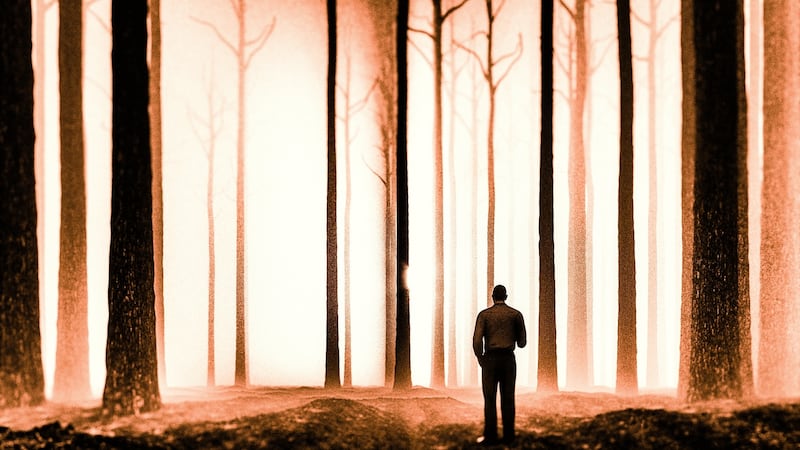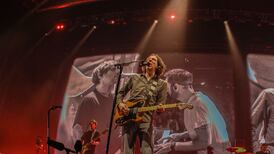“All the unhappiness of men,” the 17th-century French mathematician and philosopher Blaise Pascal famously noted, “arises from one simple fact: that they cannot sit quietly in their chamber”.
The renowned American humorist James Thurber wrote that nowadays men lead lives of noisy desperation and Danish philosopher Soren Kierkgaard declared that if he was a physician allowed to prescribe just one remedy for all the ills of the modern world, he would prescribe silence.
The Dalai Lama wrote that “silence is always the best answer” while Muhammad Ali believed that “silence is golden when you can’t think of a good answer”. Woody Allen wrote that “God is silent. Now if only man would shut up.” The poet Adrienne Rich explained the importance of silence for creativity: “The impulse to create begins – often terribly and fearfully – in a tunnel of silence. Every real poem is the breaking of an existing silence.”
Pablo Neruda in his poem Keeping Quiet, wanted the whole world to be still and “for once could do nothing/perhaps a huge silence/might interrupt this sadness/of never understanding ourselves”.
Modern life is lived at a frenetic speed of compulsive busyness and silence and quietness can only be found beneath a cacophony of traffic noise and thoughts, music and machinery, iPhones and internet intrusion. We live in a state of constant bombardment from white noise, message bleeps and pings as we get sucked into the vortex of the attention economy and disappear into a rabbit hole of online stimulation.
The sound of silence has become elusive in this age of noise despite the dignity of quiet activities such as reading, praying or contemplating a painting. Thomas Merton wrote that the silence of the world is real and that “our noise, our business, our purposes, and all our fatuous statements about our purposes, our business, and our noise: these are the illusions”.
The American critic and essayist George Steiner wrote in 1989 that there is something terribly wrong with a culture inebriated by noise and gregariousness. The sanctuary of silence and the wonder of stillness has been explored in the following books:
Silence: In the Age of Noise by Erling Kagge
Erling Kagge is an explorer, the first in history to reach the “three poles” – North, South and the summit of Everest and in the course of these expeditions experienced extreme periods of silence, the longest being 50 days. This beautiful read is a philosophical adventure consisting of 33 attempts at answering questions first prompted by a conversation with students at the University of St Andrews. What is silence? Where is it? Why is it more important now than ever?
Drawing from his own personal experiences, as well as conversations with artists, poets, athletes, philosophers and musicians, Kagge challenges the reader to grapple with the concept of silence. He quotes John Cage, the composer of 4’33”, a conceptual piece first performed in 1952 near Woodstock, New York, where the pianist walked onto the stage, sat at the piano and for 4½ minutes but made no sound. Kagge writes about the absence of sound in the musical compositions of Beethoven and Miles Davis, the unplayed notes and the sudden silences “stir the mind and create a spark in your head”.
Kagge is not advocating monasticism in this quest for silence. He lives in Oslo but manages to create a sphere of silence in his life. He regularly pauses in his working day, consciously unplugs from devices at family meals and allows himself to not constantly seek distraction. He likes to sit on his own in a room in homage to Pascal. Kagge believes that silence itself is rich, exclusive and luxurious, he doesn’t regard it “as a renunciation or something spiritual, but rather as a practical resource for living a richer life”.
Kagge writes that words and explanations are the opposite of silence and encourages the reader to open himself up to wonder and follow his own path. As an explorer, Kagge had to use his own legs to go far away to discover this but now he knows that it is possible to achieve silence anywhere. As an antidote to the age of noise he encourages us to find our own South Pole, somewhere we can mentally retreat to, somewhere far from the madding noise.
How to Do Nothing: Resisting the Attention Economy by Jenny Odell
Odell is an artist, writer and Stanford professor and this book began life as a Ted talk in 2017, where Odell talked about the importance of disengaging from online life and finding time to be alone with one’s thoughts or in careful consideration of the natural world.
In the first chapter, Odell quotes from the French philosopher Gilles Deleuze’s Negotiations 1972-1990, writing that makes sense more than ever now in this age of noise and manic productivity. Deleuze wrote that “we’re riddled with pointless talk, insane quantities of words and images. Stupidity is never blind or mute, so it’s not a problem of getting people to express themselves, but of providing little gaps of solitude and silence in which they might eventually have something to say.”
Odell’s book is a clarion call for all of us to resist having our attention and time monetised by tech companies who lure us from one hyperlink to the next. Odell herself has taken the stance of the refusenik exemplified by the Greek philosopher Diogenes whose life’s work was to expose the stupidity of conformity. She loves Melville’s Bartleby and his catchphrase “I’d prefer not to.” Deleuze wrote that solitude and silence are rich sources of new ideas bred outside of the echochamber and allowed to germinate in soils free of babble and inane chatter. “Repressive forces don’t stop people from expressing themselves, but rather force them to express themselves. What a relief to have nothing to say, the right to say nothing, because only then is there a chance of framing the rare, or ever rarer, the thing that might be worth saying.”
A Book Of Silence by Sara Maitland
Maitland’s book opens on a radiant October morning as she sits luxuriating in the view from her cottage, cloud formations, reed, rough grass, heather and bracken stretching out for many miles. She humorously writes that Virginia Woolf believed that every woman writer needed a room of her own but that she needs a moor of her own to nourish her writerly muse.

Sara writes about her noisy life growing up in a large family in Scotland, one of six children in a home where their parents encouraged them to be witty and contentious and she recalls “verbal battering, reducing people to tears, slamming doors, screaming fights and boisterous play”. She writes that introspection, solitude, silence or any withdrawal from the herd was not allowed.
After 20 years as a feminist novelist, vicar’s wife and mother, Sara embarked on a quest for silence which took her to ever more isolated houses and finally to her native Galloway. Her six-week stay in a remote cottage on Skye is her first experience of prolonged silence and isolation. She certainly experienced some downsides when she heard voices on the wind but felt that the scary times were worth it because of the delightful possibility of jouissance.
Maitland leaves no stones of silence unturned in this exploration and her sources are as diverse as Abraham, Zozimus, Enid Blyton and Kafka. The book explores the cultural dichotomy of our age, where we venerate silence as the wellspring of creativity and profound thought. We are fascinated by Buddhism and meditation but we do everything in our power to eliminate it from our lives which are lived to a loud soundtrack of modernity. Maitland writes that “in our noise-obsessed culture it is very easy to forget just how many of the major physical forces on which we depend are silent – gravity, electricity, light, tides, the unseen and unheard spinning of the whole cosmos.”
The Art of Stillness by Pico Iyer
This short book, just 64 pages, by Pico Iyer is a wonderful paean to the stationary life, an inspiring analysis of the need to escape the persistent distractability of the mundane. Iyer has spent a lifetime in pursuit of stillness and quiet. In his 20s he fled the safety of a job in Manhattan with Time magazine to live a contemplative life in the backstreets of Kyoto, Japan.
It is somewhat paradoxical that Iyer is a freelance travel writer, writing a book about staying still while traversing the globe for work. However, he always tries to carve times of stillness and silence into his life. I enjoyed his recounting a drive he took up the San Gabriel Mountains outside Los Angeles en route to interviewing his boyhood hero Leonard Cohen, who had moved to the Mount Baldy Zen Centre and was ordained a monk in 1996. Cohen took the name Jikan in the monastery, the Buddhist word for ordinary silence. Iyer found it difficult to reconcile the star with his Armani-clad, rock and roll past with the monk in a wool cap and wire-rimmed glasses sitting before him. Cohen called sitting still “the real deep entertainment” and “the most luxurious and sumptuous response to the emptiness of my own existence”. Iyer’s message is to encourage us to go nowhere every now and again, in our busy noisy lives we “have the sensation that we are standing about two inches away from a huge canvas. It’s noisy. It’s crowded. And it’s changing every second. And that screen is our lives. It’s only by stepping back and holding still, that we can begin to see what the canvass means.” Iyer wrote that “if noise is the signature tune of the world, silence is the music of the other world, the closest thing we know to the harmony of the spheres”.
Stillness is the Key by Ryan Holiday
Holiday is an Austin-based strategist who believes in downshifting one’s life in order to grasp the wonder of stillness. In Stillness is the Key, the book that completes the trilogy that began with The Obstacle is the Way and Ego is the Enemy, Holiday argues that learning the art of stillness and of slowing down is the key to making good decisions both personally and professionally.
To the ancient Stoics, if one could develop stillness, this peace within themselves, called apatheia, the world could be at war and in complete chaos, but they could maintain their tranquillity. They could still think well, work well and be well. “You may be sure that you are at peace with yourself,” Seneca wrote, “when no noise reaches you, when no word shakes you out of yourself, whether it be flattery or a threat, or merely an empty sound buzzing about you with unmeaning din.”
Holiday looks at Buddhism, Stoicism, Epicureanism, Christianity, Hinduism and other philosophical schools and religions and shows that it’s all but impossible to find one that doesn’t venerate an inner peace as the highest good and as the key to a thriving, meaningful life.
“And when basically all the wisdom of the ancient world agrees on something,” Holiday writes, “only a fool would decline to listen”. This is not a self-help book that aims to divulge the secret to inner peace, it’s not a how-to guide to attaining apatheia as solving that question, in the words of Philip Larkin, “brings the priest and the doctor/In their long coats/Running over the fields”.




















